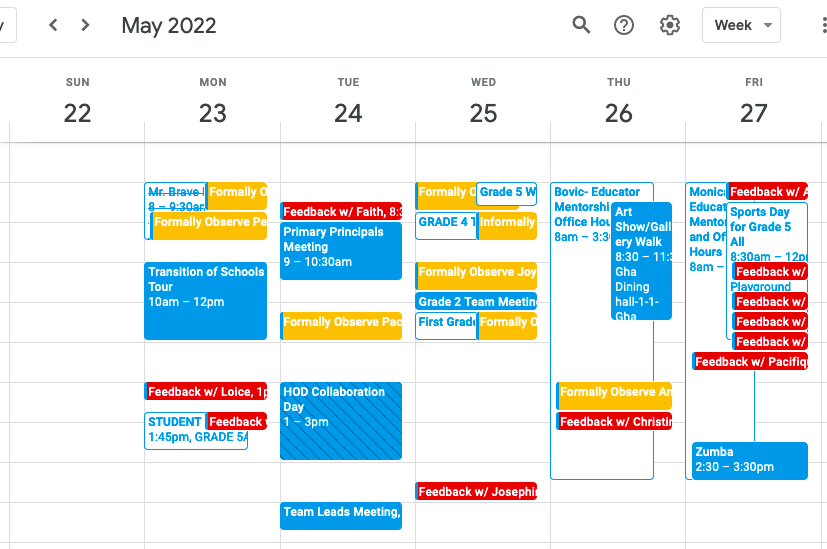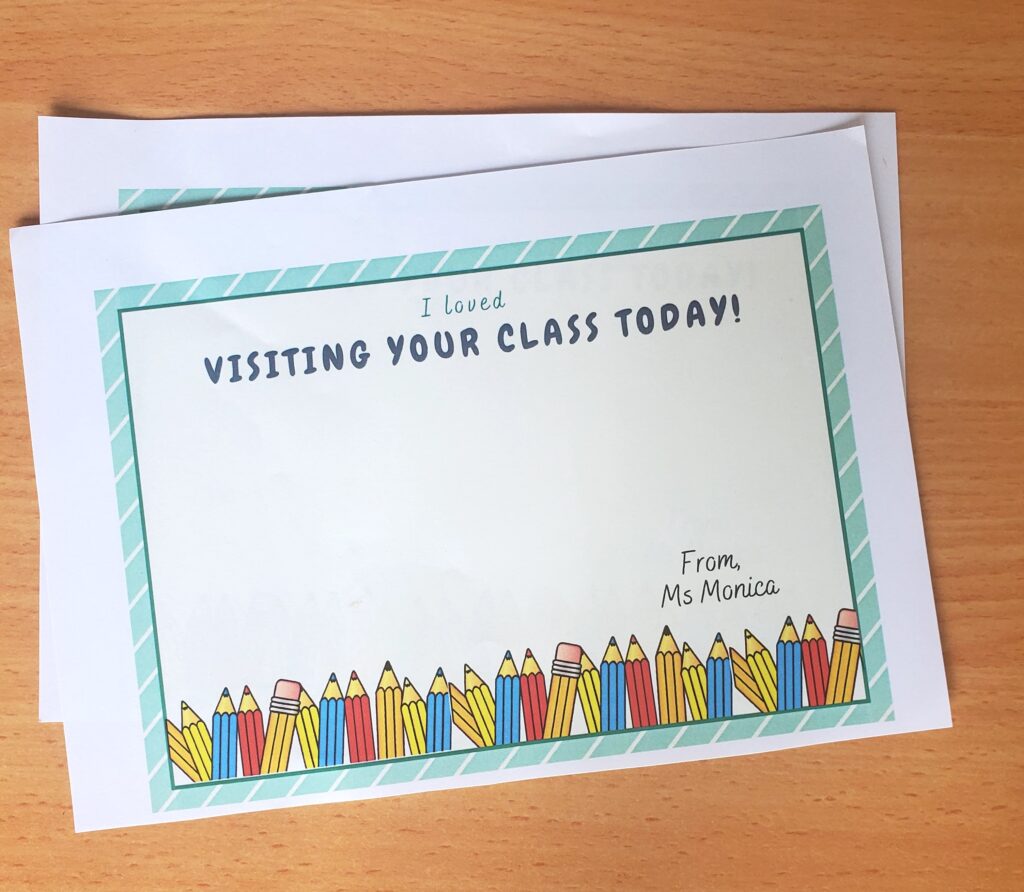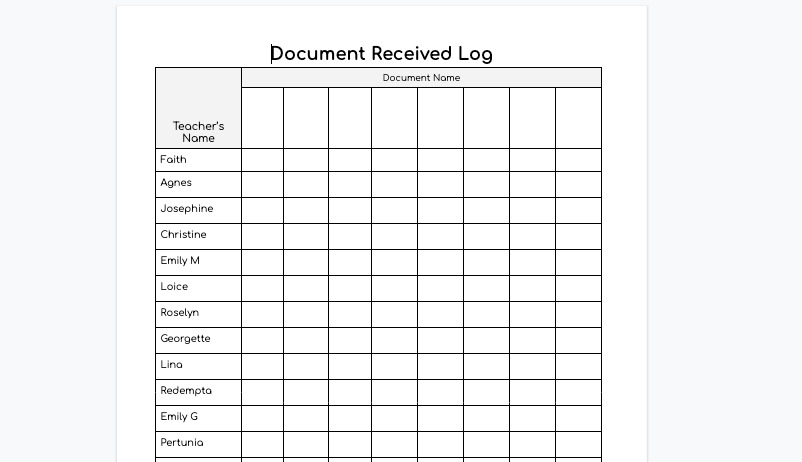I’ve had the privilege of leading professional development workshops/trainings for teachers many times in the past. I’ve been Academic Coordinator at a school in the past and worked with teachers and administrators to create school-wide programs and policies to raise academic achievement. However, this academic year was my first year in an official role as an Vice Principal. I use the word instructional coach throughout this post too because a large part of my job description is coaching teachers and delivering trainings. So, if you are an Instructional Coach all of these tips below would be helpful to you too. Here’s the top four key takeaways I’ve learned:
1. Set a schedule or plan for your week ahead of time.
As an administrator and instructional coach there will be plenty of times when things come up suddenly and unexpectedly. However, I try my best to spend some time on Friday or over the weekend setting appointments on my calendar for things that I need to do or people I need to meet with. I also use my Google Calendar to set reminders or tasks I need to finish by the end of the week. Although, sometimes things come up and I have to reschedule appointments, having the appointment still increases the likelihood that I’m going to meet with that person rather than if I just waited for a free time and deciding what to do on the spot. Here’s my calendar for next week (yeah I know it’s full!!)

Personally, I like to color code my Google Calendar. I put one-on-one meetings/ coaching sessions in red. Observations I color yellow. School wide events or admin meetings are in blue.
2. Teachers (Adults) like specific feedback that they can apply immediately.
Part of the job as an administrator is to regularly observe teachers in their classroom. Often times filling out formal observation forms for teachers. This can sometimes be a very uncomfortable and nerve-racking experience for teachers. I find that the more specific I get with my feedback, the more teachers feel happy and appreciate it. This includes also offering solutions related to the feedback instead of just noting what needs to be changed.
Example comments I’ve made on observation forms:
The repetition of vocabulary words throughout the lesson and in different ways, really helped learners remember. However, be sure to encourage speaking in sentences using the vocabulary to give it meaning. You can develop a routine of speaking at the beginning of the class: saying the date, talking about the weather. In the past I would show my learners a photo and they would describe the photo in simple sentences.
Ms Robin has organized learners in table groups so they can easily interact with one another. I would suggest mixing up the groups in different ways, for example numbering 1-5 and all the 1s get together. This gives learners a chance to move around and work with different people.
Although I am not the only administrator at my school observing teachers and giving feedback, my feedback is regularly praised by the teachers as encouraging and extremely helpful. They know that I have high standards and sometimes they are nervous coming into a feedback meeting with me, but they always leave with a smile on their face and thanking me for the feedback.
Beyond formal observations I also do informal pop-ins. I try to schedule these on my calendar too just as a way of organizing myself. For informal walk-throughs I like to leave a little note for the teachers like the one below. I made this on Canva and printed a bunch out that I keep on my desk. You can download it here. Teachers feel really encouraged just by this simple piece of paper. I try to write mostly great things I’ve seen in their classroom with maybe one simple adjustment they could make at the end. You want to make sure that teachers don’t fear you coming into their classroom.

3. Use a system to keep records
No matter how big your school is, it is vital to have a system in place to keep records. When I was over a team of 3, I didn’t need a very elaborate system. I had a google doc I created for each teacher and I wrote down dates of meeting I had with them, disciplinary action, times they were late etc.
This year, I am over 42 teachers so I have had to create a more detailed system. I don’t record disciplinary action or tardies this year because someone else in the school does that. Teachers do however, turn in a lot of documents for me to review and I’ve created a simple checklist like the one below to keep track of who has turned in what. I made this checklist on Google Docs.
I also have another checklist that I use to keep track of when I go into classrooms (both informally and formally). The teacher’s name is on the left and I record the date in the box each time I enter the classroom for a pop-in. This helps me see whether I’ve been leaving anyone out.
These records are important to you as a admin, to help keep you organized. But they are also important in case you ever need to take disciplinary action with a teacher. You must have records to back up the discipline.

4. Get creative and vary coaching opportunities
I hear leaders all the time say “we need to have a PD about _______” . Whenever they notice that teachers are weak in a particular area the answer always seems to be having a PD. However, the reality is that schools and teachers are busy. It is really difficult to carve out time to have a school-wide PD session. I haven’t delivered a formal PD at my school in 4 months! As an administrator or instructional coach you need to get creative.

Think of other ways you can mentor and coach teachers in small groups or one-on-one. I choose two teachers this year to offer an intensive one-on-one coaching to. I sent them an email invitation asking them if they wanted to participate and then we sat down together and they decided on what the goal of the coaching cycle would be.
One of the teachers later told my Principal that I “changed her life” through that coaching cycle. I felt so encouraged.
A benefit of getting creative and offering different development opportunities outside of PDs means that it gives teachers choice to decide what opportunities they feel will benefit them the most. Besides the one-on-one coaching I do I also offer monthly PD in a Box where teachers can read about a new strategy for their classroom and apply it on their own. I have done instructional rounds, where I take a few teachers into another teacher’s classroom for about 10 mins and we observe that teacher together.
Teachers learn in different ways just like students and I find that when they choose the topics, and style of learning that best fits them, they are more eager to apply what they learn.
If you want to hear more about PD in a Box or creative ways I coach teachers, check out my post 3 Alternatives to Professional Development Workshops.
More posts you might like:



